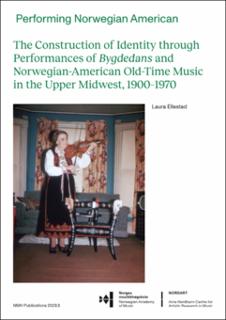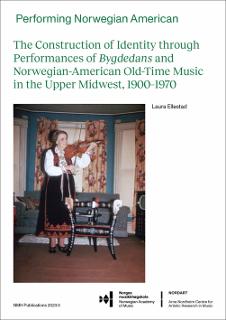| dc.contributor.author | Ellestad, Laura | |
| dc.date.accessioned | 2023-05-22T11:18:35Z | |
| dc.date.available | 2023-05-22T11:18:35Z | |
| dc.date.issued | 2023 | |
| dc.identifier.isbn | 978-82-7853-319-2 (print) | |
| dc.identifier.isbn | 978-82-7853-320-8 (pdf) | |
| dc.identifier.issn | 0333-3760 | |
| dc.identifier.issn | 2535-373X (online) | |
| dc.identifier.uri | https://hdl.handle.net/11250/3068488 | |
| dc.description | Dissertation for the PhD degree Norwegian Academy of Music, Oslo 2023 - Avhandling (Ph.D.) - Norges musikkhøgskole, Oslo 2023 | en_US |
| dc.description.abstract | Abstract -
This comparative study examines the music culture of the Norwegian-American communities in five states of the American Upper Midwest (Iowa, Minnesota, North Dakota, South Dakota, and Wisconsin) between 1900 and 1970, investigating the shifting ways in which performances of the two music genres of bygdedans and Norwegian-American old-time music functioned to construct heterogeneous Norwegian-American identities during a period of major social,
cultural, technological, political, and economic change in the United States. Through case studies of two historical performers, Dagny Andrea Veum Quisling and Daniel Aakhus, the study examines a selection of performance contexts for each genre, analyzing the musical expression of diverse layers of identity through these contexts. The study also investigates how a combination of global and local flows and forces contributed to processes of musical change and exchange in the Norwegian-American music culture, and furthermore, how these processes reflect diverse processes of identity construction.
This qualitative, interdisciplinary study draws on theory and methodology from a range of humanities and social science disciplines, including ethnomusicology, anthropology, sociology, migration studies, cultural studies, performance studies, folklore studies, and media studies. The approach towards the study of the musical performance of Norwegian-American identity is grounded on an interdisciplinary theoretical framework centred on concepts of social identity (particularly ethnic and diasporic identity), performance, and globalization theories as connected to ethnomusicologist Mark Slobin’s framework for the study of subcultural musics (Slobin, 1993). The strategy of inquiry combines historical research and case study research. Data collection was accomplished through archival research, qualitative interviews, fieldwork, and the collection of qualitative documents, audiovisual materials, and artifacts. Data management and analysis involved the use of a relational database, spreadsheets, and computer-assisted data analysis software. As a supplemental tool, I have also learned and performed music from the repertoires of several historical performers investigated in this study.
Through analyses of multiple examples of musical interplay drawn from the collected data, the study found that Norwegian-American musicians interacted with global and local cultural flows and forces through three broad processes of interplay: intersubcultural interaction (i.e. interactions with musicians of various ethnic groups settled in the region); the use of
supercultural materials (interplay with various popular music genres transmitted through a diversity of channels and media, including travelling entertainment, sheet music, phonograph recordings, and radio); and interplay via the diasporic interculture (direct and disembodied interactions between Norwegian-American musicians and Norwegian musicians). Further, these processes of interplay were found to reflect two main dynamics of Norwegian-American identity construction: plasticity, permeability, and ethnic boundary negotiation; and positioning and mythmaking processes. Through case studies of performers Dagny Andrea Veum Quisling and Daniel Aakhus, performance contexts were found to have served important
functions related to identity construction, including the reconstruction of idealized notions of Norwegian national and regional culture; the display of compatibility between ethnic cultural practices and American ideals; and the affirmation of loyalty to Norwegian homeland cultural traditions. The investigation has also shown that performances functioned as outlets, or frameworks, for the reflexive regulation of emotions and self-worth, and as intermediaries for immigrants facing complex issues of adaptation to American society. | en_US |
| dc.description.abstract | Sammendrag -
Denne komparative studien gransker musikkulturen i norsk-amerikanske samfunn fra 1900 til 1970 i fem delstater i det amerikanske øvre Midtvesten (Iowa, Minnesota, Nord-Dakota, Sør-Dakota og Wisconsin) i perioden fra 1900 til 1970. Studien undersøker hvordan framføringsformer av de to musikksjangrene bygdedans og norsk-amerikansk old-time music på ulike måter bidro til å skape mangfoldige norsk-amerikanske identiteter i en periode med store sosiale, kulturelle, teknologiske, politiske og økonomiske endringer i USA. Ved casestudier av to historiske utøvere, Dagny Andrea Veum Quisling og Daniel Aakhus, blir et utvalg av framføringskontekster tilknyttet hver sjanger undersøkt. Studien undersøker også hvordan globale og lokale strømninger og krefter bidro til endringer og utvekslinger i den norsk-amerikanske musikkulturen og videre hvordan disse prosessene avspeiler ulike prosesser bak identitetskonstruksjon.
Studien er kvalitativ og tverrfaglig og bruker teori og metoder fra en rekke humanistiske og samfunnsvitenskapelige disipliner, inkludert etnomusikologi, antropologi, sosiologi, migrasjonsstudier, kulturstudier, performance-studier, folkloristikk og mediestudier. Arbeidet tar utgangspunkt i begreper om sosial, etnisk og diasporisk identitet, samt performance og globaliseringsteorier knyttet til etnomusikologen Mark Slobins rammeverk for studier av subkulturell musikk (Slobin, 1993). Studien anvender både historisk basert forskning og casestudieforskning. Data er hentet fra arkiver, kvalitative intervjuer, feltarbeid, samt dokumenter, audiovisuelt materiale og annet tilgjengelig materiale. I analysedelen har relasjonsdatabase,
regneark og datamaskinassistert kvalitativ dataanalyse (CAQDAS) blitt benyttet. Som et supplement i arbeidet har jeg også innstudert og fremført musikk fra repertoaret til flere av de historiske utøverne som er forsket på i studien.
Et funn i forskningsarbeidet er at norsk-amerikanske musikere interagerte med lokale og globale strømninger gjennom tre typer prosesser: intersubcultural interaction (interaksjon med musikere fra ulike etniske grupper bosatt i regionen), bruk av supercultural materiale (interaksjon med forskjellige populærmusikksjangre formidlet gjennom ulike kanaler og medier, inkludert omreisende underholdningsmusikere, noter, grammofonplater og radio) og samspill via the diasporic interculture (direkte og indirekte interaksjoner mellom norsk-amerikanske og norske musikere). Disse samspillsprosessene reflekterer på sin side to dynamiske forløp ved norsk-amerikansk identitetskonstruksjon: formbarhet, permeabilitet og etnisk grenseforhandling på den ene siden og posisjonerings- og myteskapingsprosesser på den andre. Casestudier av de to utøverne Dagny Andrea Veum Quisling og Daniel Aakhus viser at framføringskontekster var viktige for konstruksjonen av identitet, inkludert rekonstruksjon
av idealiserte forestillinger om norsk nasjonal og regional kultur, påvisning av kompatibilitet mellom etnisk kulturell praksis og amerikanske idealer og en bekreftelse av lojalitet til norske kulturtradisjoner. Undersøkelsen har også vist at musikalske uttrykk fungerte som utløp eller rammer for refleksiv regulering av følelser og egenverdi, og som kulturelt bindeledd for innvandrere
som sto overfor kompliserte spørsmål om tilpasning til det amerikanske samfunnet. | en_US |
| dc.language.iso | eng | en_US |
| dc.publisher | Norges musikkhøgskole | en_US |
| dc.relation.ispartofseries | NMH-publikasjoner;2023:3 | |
| dc.subject | qualitative study | en_US |
| dc.subject | interdisciplinary study | en_US |
| dc.subject | Mark Slobin | en_US |
| dc.subject | subcultural musics | en_US |
| dc.subject | musical practies | en_US |
| dc.subject | Norwegian -American identity | en_US |
| dc.subject | bygdedans | en_US |
| dc.subject | Norwegian-American oldtime music | en_US |
| dc.subject | identity construction | en_US |
| dc.subject | Dagny Andrea Veum Quisling | en_US |
| dc.subject | Daniel Aakhus | en_US |
| dc.title | Performing Norwegian American. The construction of identity through performances of bygdedans and Norwegian-American old-time music in the Upper Midwest, 1900–1970 | en_US |
| dc.type | Doctoral thesis | en_US |
| dc.description.version | publishedVersion | en_US |
| dc.subject.nsi | VDP::Humaniora: 000::Musikkvitenskap: 110::Annen musikkvitenskap: 119 | en_US |
| dc.source.pagenumber | xi, 310 sidr | en_US |

